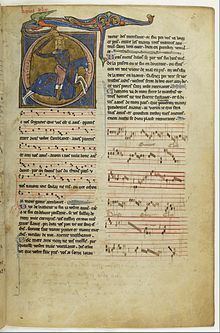 | ||
The Manuscrit du Roi or Chansonnier du Roi ("King's Manuscript" or "King's Songbook" in English) is a prominent songbook drawn towards the middle of the thirteenth century, probably between 1255 and 1260 and a major testimony of European medieval music. It is currently French manuscript 844 of the Bibliothèque nationale de France. It is also troubadour manuscript W in the lettering of Karl Bartsch, trouvère manuscript M and motet manuscript R.
Contents
Background
The manuscript contains more than 600 songs composed for the most part between the late twelfth and early thirteenth century. Some were written by famous troubadours and trouvères as Guiot de Dijon or Richard de Fournival, but others are anonymous. It contains as an addendum a booklet of songs by King Theobald I of Navarre, sometimes known as manuscript Mt. Around 85% of its material is French, while only 61 songs are by troubadours. Of these, 51 have music.
The creation of this songbook is attributed to Count Charles of Anjou, who probably had it made as a gift for William of Villehardouin, Prince of Achaea. In 1270, it returned to Charles's possession. Today, the state of conservation of the collection is bad. Eighteen pages have are missing and several decorative initials have been cut out, but it is remains a major testimony of medieval music.
